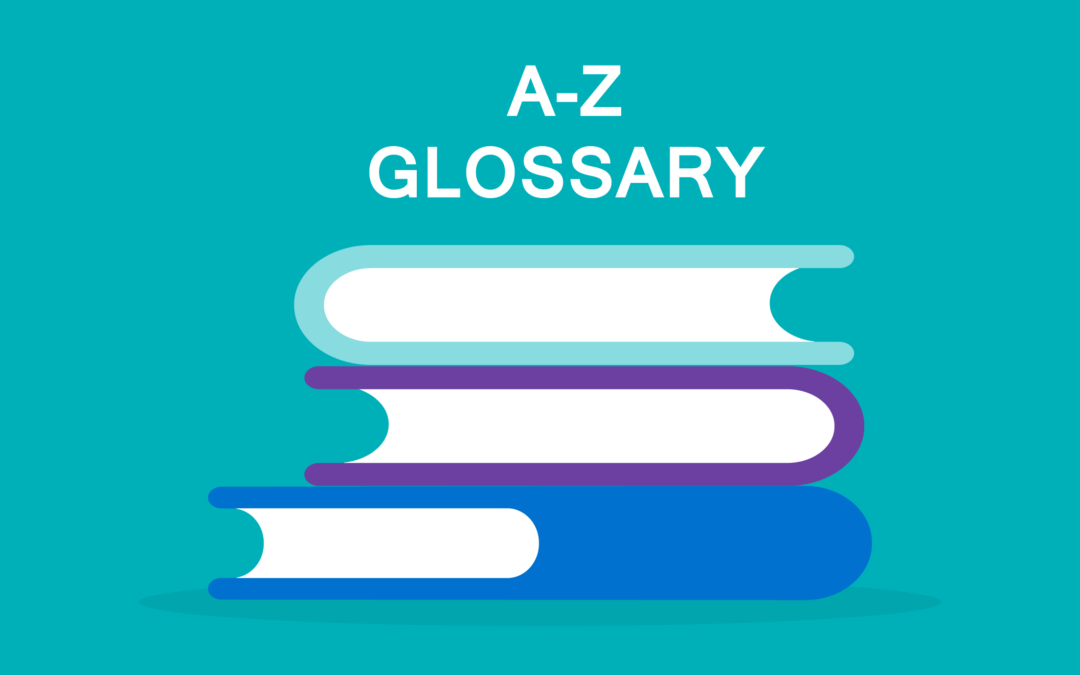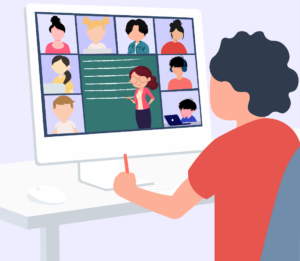
Freestone delivers a powerful learning experience that meets the needs of both presenters and participants. Our learning management system will translate the most important terms for you. As you start to think of what’s ahead in 2022, take some time to get familiar with these commonly used terms.
AR (augmented reality) – This is any software that makes alterations to a user’s view of the surrounding world. AR is a recent entrant into the eLearning scene with fantastic implications for the future of corporate training. via GIPHY
AICC – a standard providing course content compliance with web-based learning requirements, facilitating proper communication between the course content and the learning management system.
Asynchronous learning – a type of online learning that can happen even if a student is offline. A student can study at their own pace and communicate with classmates and teachers by means of posting questions at forums and sending emails.
Authoring Tool – software used to create a SCORM compatible eLearning content that can be deployed into any SCORM conformant Learning Management System without need to start all over again if you decide to move to another learning management system. Read More: The Top 12 eLearning Authoring Tools (2021 Update)
![]()
Blended learning – Sometimes called hybrid learning, this process combines eLearning and in-person teaching or discussions. In a blended learning course, learners complete some components independently through an eLearning system, and others in a traditional classroom setting.
Case-based storytelling – bringing as examples cases that need to be resolved.
Channel learning – Channel learning happens when organizations share learning management system content with others. For example, one firm might find it useful to borrow content from another company instead of recreating a similar course. Sharing content between one LMS and another is easy and effective because of the standards governing LMS content objects (See: SCORM).
CLCIMS – An acronym for computer learning content information management system. CLCIMS refers to any SCORM-compliant learning content system. It’s a comprehensive name for both learning management system and LCMS.
Cloud – a set of remote servers where the data is stored and can be accessed from anywhere.
Cloud LMS (also called SAAS, on-demand LMS, multitenant LMS) – a Learning Management System hosted in the cloud.
CMS (Content Management System) – a web-based application used to build a website and manage content within a common interface. The system of permissions allows multiple users to access the CMS without interfering with each other.
Collaborative learning – A general name covering group learning. In learning management system learning, collaborative learning is facilitated by social learning tools—such as a virtual classroom or an application-sharing tool—that allow either simultaneous or staggered work.
Competency-based Learning – an approach to learning designed to develop specific skills and competencies rather than abstract knowledge.
CBT (Computer-based Training) – is a generic term covering any training that uses a computer. Learning through a learning management system is one type of CBT.
Content library – an online database of LMS content. Some learning management systems come with access to a content library. If not, you can build your own with an LCMS. The content you build with is accessible in individual units or as whole courses. You can load it into your learning management system and give learners access through your course catalog.
Corporate training – an improvement of employees’ professional knowledge and skills that the company needs to conduct for its business success and development.
Course authoring – the act of producing course content for learners using a learning management system. Authoring can involve adapting a course taught in a traditional classroom or producing new content specifically for your LMS. Also known as Course Designing.
Course catalog – the manager of your learning management system uploads courses to the system, which are then centralized in the course catalog. Learners can access the catalog to register for courses.

eLearning – a type of learning that is delivered over the internet. Learning happens outside of a traditional classroom, by using a learning management system to deliver learning materials and webinar services to replace face-to-face communication. It may also be called distance learning, online learning, computer-based learning, web-based learning and there are different eLearning techniques such as mobile learning[KG1] , blended learning, flipped learning, rapid learning, social learning etc.
eLearning content chunking – a process of dividing information into small pieces and grouping them together so they can be stored and processed easily.
eLearning personalization – a method of customizing the right type of learning for the right type of audience. Personalized learning is the opposite of a “one size fits all” model used in a traditional education. A learning curriculum and activities are adjusted to students’ skills rather than to the age or grade.
Face-to-face learning – a traditional learning that requires a teacher and students to be located in the same physical classroom.
Flipped learning – a model of teaching in which students study learning material at home by watching videos and come to the class to get a deeper understanding of a topic, discuss unclear moments and interact with the classmates.
Formal learning – a type of learning that is planned, structured and guided by an instructor/teacher.
Game-based learning – the use of games in learning and training. The main idea is to help a student to apply the skills gained in games to a real-world environment.
Gamification – a type of learning implying the usage of game elements such as badges, levels, achievements, points, allowing users to design avatars, or offering prizes for material completion and comprehension to increase students’ engagement in the learning process. Read More: What is Gamification?
Gradebook – an online or in-app page where student grades are collected, calculated, and displayed.
Gray-labeling – a form of branding where software allows both its own logo/design and your company or organization’s logo/design to be present in an application. This is a great option for schools or companies that want to customize learner experience (See: White labeling).
HTML5 (Hypertext Markup Language) – a markup language used to design courses accessible on mobile devices.
ILT (Instructor Led Training) – ILT is often contrasted with web-based training to mean live training in a physical classroom, with one person leading the class. It can also generically reference training led by one person in either a physical or virtual classroom.
Implementation – the process of installing and using software or specific features.
Instructional design – learning content that is organized around course learning objectives and tailored to a learner’s needs.
Informal learning – an ongoing process of gaining new skills and knowledge through peer and colleague observations, reading blogs and news sources, communication on forums, watching YouTube videos, etc.
Installed LMS (also called on-premise LMS, deployed LMS, in-house LMS) – Learning Management System installed at the client’s server.
Instructional design – a practice of analyzing, designing and developing instructional materials and transferring them into an online curriculum.
Just-In-Time learning – a type of learning focused on gaining particular knowledge instead of learning everything. Read More: 7 Ways to Incorporate ‘Just-In-Time Learning’ with your LMS
Learning content – a generic term for information made available through a learning management system. Learning content includes the facts or skills being taught, as well as the method of teaching and the form the course takes.
Learning object – a learning content element focused on one learning objective, shareable between learning management systems. Learning objects can be classified and organized within an LCMS to facilitate easy reuse.
Learning pathway – the order in which a learner completes LMS eLearning content. A learning pathway can be established by a learning management system manager or by learners themselves. Learning paths stipulate how long it takes a learner to master content or specific skills. You can experiment and determine the best learning path for your learners using your LMS.
LCMS (Learning Content Management System) – a system used to create and manage eLearning content. The main difference between an LMS and an LCMS is the target user. A learning management system focuses on learners, while an LCMS is primarily used by content creators.
Learning path – a sequence of steps a student needs to take to pass the course and get a certificate.
Lifelong learning – a combination of formal and informal learning continuing throughout a whole life.
LMS (Learning Management System) – software used for creating, managing and delivering eLearning content as well as communication with students and tracking their performance. There are Learning Management Systems hosted in the cloud and installed at the clients’ websites. The courses are either created with the help of native learning management system tools such as documents, quizzes, links or uploaded as SCORM/AICC packages.
LTI (Learning Tools Interoperability) – a standard allowing learning management system vendors to add integration with third-party services. It is a framework within which an LMS sends information about a learner to a third-party tool or software, enabling single sign-on, data exchange and a seamless user experience.
Micro-learning – a way of teaching that implies delivering eLearning content in small units (chunks, learning snacks) for better retention and higher engagement.
Mobile learning (mLearning) – when learning occurs via a mobile device (such as a tablet or smartphone). Some learning management systems support user access to course content through a mobile device, and some use mobile learning as an extension of their program’s social learning aspects. via GIPHY
On-premise hosting – in contrast to cloud hosting, on-premise hosting means hosting software on a server in your physical office. This is a good option for large companies or businesses that like having an extra level of control over their data.
Open-source software – software that has an open (and, therefore, editable) source code. Often free, open-source software is an excellent choice for businesses on a budget or tech-savvy businesses who want to customize their learning management system experience.
OTJ training (On-The-Job training) – this is any training that takes place after onboarding where an employee learns as they work.
“One size fits all” eLearning Model – a learning model suitable for all types of learners independently of their skills and the level of knowledge.
Problem-based storytelling – teaching how to solve the problem with the best results.
Portal – the starting page or homepage of an application or software. In a learning management system, instructors, admins, course designers, and learners will likely see different versions of the portal based on their administrative privileges.
Progress reports – updates on how a learner has performed against predefined standards established by learning management system managers. These reports give the course administrator insight into the learner’s progress, weak points, and overall course completion.
Rapid Learning – a process of creating courses within shorter period of time, within smaller budget, making fewer efforts and involving minimum resources.
Responsive Design LMS – a learning management system which layout adjusts to the screen of a device used.

ROI (Return On Investments) – a performance indicator measuring the profit after all costs deducted. In relation to eLearning costs include the cost of course development, LMS, authoring tools etc.
Rapid authoring – a content creation method frequently offered as a learning management system feature that makes the transfer of information to the SCO format fast and easy. A rapid authoring tool can take a PowerPoint presentation and integrate it with an audio recording of the presentation by using built-in, interactive LMS functions. Rapid authoring is useful for people who want to create hybrid content but aren’t proficient in the technicalities of LMS content standards. The rapid authoring tool lets you import any information you choose and produces learning content that can be shared between LMSs.
SaaS – an acronym for software-as-a-service. This term describes companies that host software and sell licenses to use it.
Scalable LMS – a learning management system that allows increasing the number of seats on demand.
Scenario-based learning – a type of learning in which a learner becomes a part of the story and achieves different outcomes depending on certain decisions.
SCO (Shareable Content Object) – a launchable learning object that communicates back to the learning management system that launched it. A learner can open an SCO in a web browser and complete the objective there. When they’re finished, their results and records are saved in the LMS.
SCORM (Sharable Content Object Reference Model)– a collection of standards ensuring content compatibility with any SCORM compliant learning management system. A SCORM compatible content is created with authoring tools and can be reused and transferred to a new LMS with no need to spend money and efforts on the content remaking.
Self-paced learning – a type of learning directed by a student, not an instructor. A student determines the amount of time to study as well as a comfortable place to access the courses from.
Social learning – learning that takes place at a wider scale than individual or group learning, up to a societal scale, through social interaction between peers. Encompasses both collaborative learning and informal learning some learning management systems try to replicate this type of learning in a virtual environment through social tools designed to facilitate cooperation (such as chat rooms or video conferencing). Some even include social media platforms to encourage a culture of informal learning among students.
Storytelling – a process of presenting data by means of entertaining and memorable stories.
Student-Centered Approach to eLearning – a way of teaching in which a student is put at the very center of the learning process. A teacher adjusts a curriculum, materials delivery and class activities to the students’ skills and the level of knowledge. The student-centered classroom allows students not to just pass, but to learn in a deep and fundamentally appropriate way.
Synchronous Learning – a type of online learning that requires both a teacher and a student to be online at the same time. Communication happens through chatting and video conferencing. Read More: The Pros and Cons of Synchronous Distance Learning
Tin Can (also called Experience API or xAPI) – the next generation of SCORM eLearning standard allowing tracking learning activities happening outside the learning management system (like attending conferences, writing blogs, social communication etc.)
Talent management system – human resources software that facilitates recruiting, performance management, training and development, and compensation activities. Some learning management systems can integrate with talent management systems, and others have performance management functionalities that serve as talent management. For example, certain LMSs support 360-degree reviews. In these reviews, fellow learners rate the performance of a particular learner, letting you determine what further training that learner needs.
VLE (Virtual Learning Environment) – an eLearning setting modeled after the elements of traditional learning that can include textbook-like content or a recorded lecture. In a virtual learning environment, learners interact with one another through chat sessions or other social learning tools, just as students in a classroom interact with each other as part of the learning process.
VR (Virtual reality) – in contrast to augmented reality, VR gives you a virtual 360-degree world, usually with the use of a special headset and sometimes with motion-tracking gloves or boots. Like AR, VR is a new tool for eLearning with the potential to be a great asset for virtual training simulations.
Virtual classroom – an online classroom where learning and collaboration happen. There is a chat, whiteboard, video and audio capabilities enabled.
WBT (web-based training) – an acronym for web-based training. Often used to reference any learning that happens online.
Whiteboard – an application allowing drawing online. via GIPHY
White labeling – similar to gray labeling, white labeling is a branding option that removes the name of a software’s developer and customizes the view to feature your company’s name instead. It’s usually more expensive than gray labeling, but can provide a more cohesive theme for company-specific learning materials.
xAPI: also known as tin can API. The successor to SCORM, xAPI is an API that standardizes learning content for cross-platform sharing.
Freestone provides an intuitive, user-friendly experience that makes it easy to both present and participate in events. Featuring a variety of interactive tools that help online courses meet live learning requirements, this customizable solution not only makes a powerful learning management system first impression. It also provides a seamless administrative experience for organizations seeking to build content offerings and identifying potential revenue opportunities.
To learn more about how Freestone delivers a powerful learning experience that meets the needs of both presenters and participants, contact us today for a guided demo of the platform.